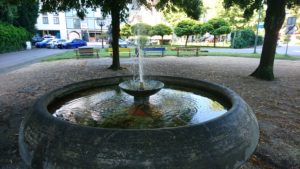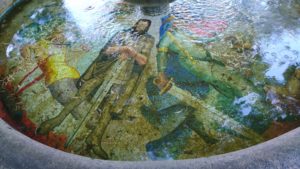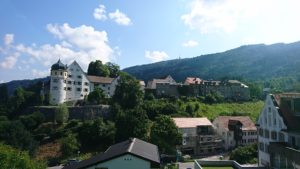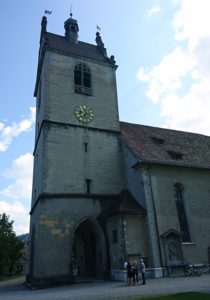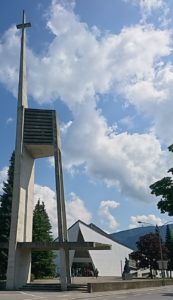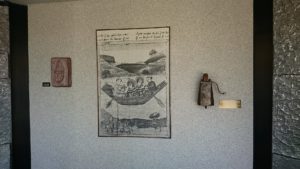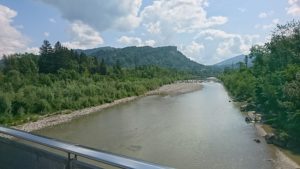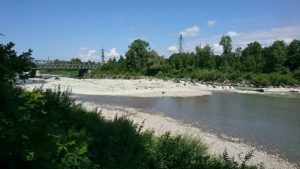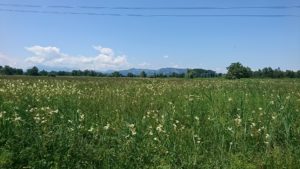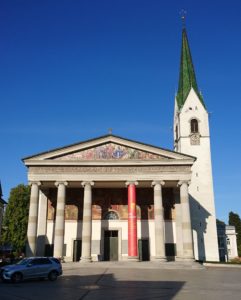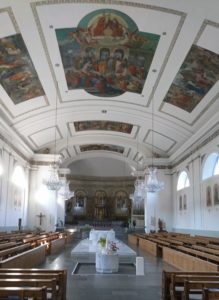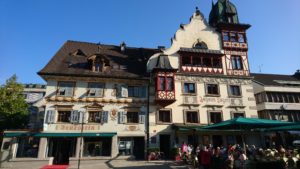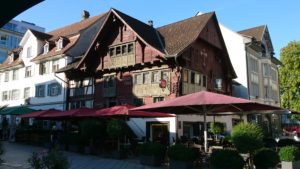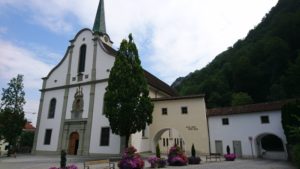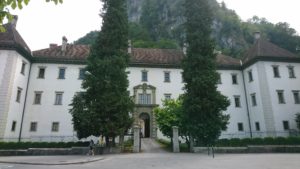We start today’s trail at St Gall’s Church.
Worth seeing and knowing
Just under a kilometer away, at the foot of Gebhardsberg (on the top of which there is a popular pilgrimage chapel), we arrive at Columbanus’ Church, built between 1962 and 1966. After a further 300 meters, we come to the banks of the Bregenzer Ach River which we cross and follow westwards for about a kilometer. When reaching the railway bridge we walk southwards alongside the railway lines for about a kilometer.
When we finally leave Bregenz behind us, we hike along the outskirts of the municipal district of Lauterach. The hiking trail, marked in yellow and white, leads us about half a kilometer along the railway line to a right curve. We follow the railway line a further 500m until we come to an underpass. We cross under the railway tracks and now follow the sign to Jannersee. This small lake lies in the middle of the Lauteracher Riet and offers a simple resting place.
We stay on this path and after another 2.5km reach the banks of the Dornbirner Ach. We turn to the left and a little over a kilometer further we come to a wooden bridge, which we cross (attention, traffic!) and then immediately turn left again. Following the now meandering Ache, we hike towards Dornbirn, cross under the motorway, and continue on the banks of the Dornbirn Ach.
If you want to visit the city, leave the Ach after approx. 3.5km and turn to the city center. If you go straight on, you follow the Ache.
| Km 15 | Dornbirn: The earliest signs of human presence in the Dornbirn of today date back to the Mesolithic period (8000-3000 BC). Coins from the 2nd Century and a brooch from the 1st Century indicate Roman presence in this area. The first evidence of a settlement here is an Alemanni Grave from the 6th and 7th Centuries.
Dornbirn is mentioned in a St Gallen document issued in 895. According to this, Dornbirn belonged to the Monastery of St Gallen in the following decades. Just like the whole of the Rhine Valley, the textile industry was, and still is today, an important industry. Numerous chapels suggest the great religiousness of the community. A cable car runs up to the Karren, a beautiful lookout point. From there one can walk downhill through the impressive Rappenloch Gorge. This can also be reached directly from the town center. Along the foot of the mountain, we now continue our trail to Hohenems. |
| Km 24 | Hohenems. The Hohenems Palace, the former residence of the Earls of Hohenems, is located in the town. In the 18th Century, two of the three most important manuscripts of the Song of the Nibelungs were found in the Palace library. Hohenems was the residence of numerous Jewish families from the 17th Century to the 19th Century. In the 20th Century, Hohenems became world famous for its annual Schubertiade Music Festival.
There are two routes from Hohenems to Chur: Stages 14a Hohenems – Feldkirch, 15a Feldkirch – Balzers and 16a Balzers – Chur Stages 14b Hohenems – Haag, 15b Haag – Sargans and 16b Sargans – Chur The variant on Haag and Sargans offers the opportunity to visit a place that played an important role in the Gallus vita: Grabs. This is where Gallus fled across the Saxerlücke – a mountain above Grabs – to avoid possible reprisals by the Duke. In Grabs he also decided not to follow Columban to Bobbio but to retire to Steinachtobel. A fountain and the Gallus-Center with Columbans Way plaque commemorate Gallus‘ presence in this place. |




















